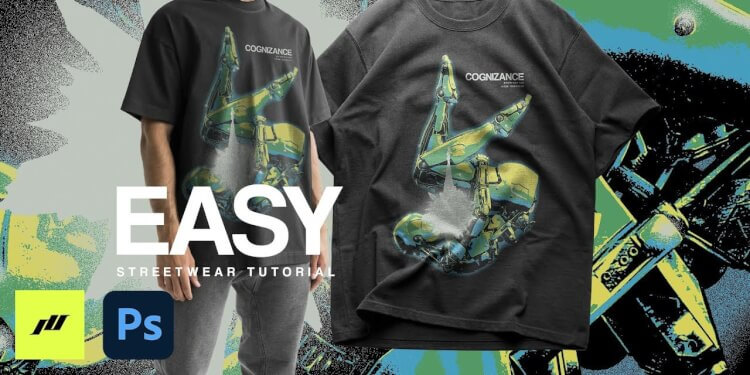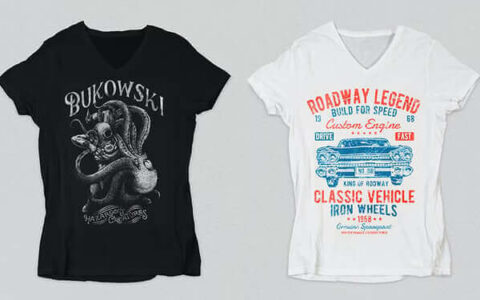In the world of shirt design, there are a few important rules that you need to keep in mind before you go. I wanted to talk about three of those tips that I thought were most important.
In the world of shirt design, there are a few important rules that you need to keep in mind before you go, and list your designs on sites like Redbubble and Society 6. Now, a couple weeks ago, I had the opportunity to sit down with my friend Junna from DetourShirts here on YouTube, and we talked about 10 Amazing Tips for people that are starting to get into printon demand specifically forshirts. So I strongly encourage you to go check out that post. I'll link it right here. But today, in this post, I wanted to talk about three of those tips that I thought were most important. I'm justgonna elaborate them a little bit. So for rule number one, the first rule we want to think about is to fill that rectangle.

Printon-Demand Shirt Designs – Filling That Full Rectangle Space
Now, when it comes to shirt designs, I know there are a lot of different methods and shapes you can use. But when we look in the printon-demand world, a lot of the most popular designs are going to be filling that full rectangle space, and what I mean by that is using the whole estate for that shirt, which is commonly a size like 16 by 20 inches, or something like that, which is commonly what you're going to want for printon-demands like Redbubble or Merch, by Amazon or something like that. Now, of course, this isn't a hard and fast rule when it comes to shirt designs. Of course, you could use something like a nice badge, maybe in the middle of the shirt, or you could have some nice script writing or something across the chest, maybe if you're an apparel brand or something like that. But if you're just starting to get into the printon-demand space, you're not probably throwing your own personal logo or something on a shirt for people to buy. Most likely you're going to do some research.
You're going to find some designs that do well and come up with a design that makes use of that full composition, that full estate on the front of the shirt. And, by the way, with Composition filling that rectangle really helps you with full layout, because you can use illustrations and typography together to make a really nice full layout, instead of having something like an illustration kind of floating in the middle or the bottom of the shirt, and then you have a lot of negative space kind of elsewhere. So it helps you fill and use all of the available space for the shirt. So if we look in kiddo here, for example, we have a ton of shirt templates made by fantastic designers all over the world, and what you'll notice is that they all fill this space really nicely. obviously not all of them, but once you start to understand the rules of shirt design, you can get creative with how you might design something smaller for the chest or maybe for the pocket of a shirt, and so, either way, this is a really good rule of thumb when it comes to shirt design.
Printon-Demand – Rule Number 2 – Limit Your Colors
Okay, rule number 2 is about colors, and you're going to want to be careful with the amount of colors you use. I don't mean that colors are going dangerous. Certain colors are dangerous. Certain colors are not available to you. I just mean we want to limit the amount of colors we use, because if you're in something like screen printing or even ordering heat transfers or something like that, you're probably going to find that the more colors that you use is going make that design more expensive. And so if we limit our colors, we're going to be able to have a moreaesthetically pleasing design and probably save you some money now. For some printon-demand sites that are using DTG printing, which means direct to garment, this probably isn't going to be an issue, and you could probably use as many colors as you want. But I'm going still err on the side of a limited palette because we don't want to get too crazy so that our design is distracting. I know that it's tempting to add more colors because you want that design to be vivid, but it could end up doing the opposite effect and tracting the user from what's going on in the design.
And I don't really have a magic number for you in terms of how many colors to use. I would just try to use a select core group of colors. So if we look at these two examples here, the one on the left has way too many colors going on, and I can understand that in real life, a lot of these items and elements and pieces will have different colors. But for sure design, we're going less for realism and more so design aesthetic. So the same design on the right side here is much more balanced, still has several colors in it, but it's moreaesthetically pleasing to the eye. So, just to recap, be careful with your color choices. Just try to limit it. Don't go too crazy with something like 15 or 20 designs, because one might get expensive depending on how you're printing and two, it may get too distracting for the viewer.
Keep Your Shirt Design Simple
All right, the last rule is to just keep your shirt design simple, And you might be thinking: "Well, those aren't super simple." So what? What do you mean? And I don't necessarily mean like a simple shape with some simple text on a shirt and boom, that's good to go. It's simple. What I mean is, is the design simple to understand? Can the audience look at it? Can your viewer look at it and immediately know what's going on in the shirt? In other words, don't try to explain an entire movie plot on your shirt, when really you're just working on one scene. So in this beach themed shirt we have a pretty simple concept. We've got a nice retro looking Jeep with a surfboard on top with some sun and birds in the background, and then we have some nice text on the top and bottom that really fits and frames this surf camp shirt, and it fills out the rectangle, which was our first rule, and it uses a limited color palette, which we can see down here in the right, and that's our second point.
So this is an example that hits all three shirt rules, plus it's a template in kite, so you can start using this right away. By the way, I'll link it down below. Even in this shirt design here, while it is true that there's a lot going on, and you might not call this design simple, the message is coming across easily and is very simple to understand. At the base, in the center, you have that ukulele illustration, nice and big, right there in the middle, and the text below reads the same thing. Then the littlehack and the birds and the dog in the background kind of blend in with this whole aesthetic. They just become a part of the scene and they aren't distracting because you've already understood the message. Even the florals that are wrapped around the ukulele just help create the vibe of this tropical Hawaiian style environment. And if we think about our other two rules, it definitely fills the rectangle. and for rule two about colors, it's certainly on the side of more colors than the previous design we looked at, but again for DTG printing, this would not be a problem at all. I actually know that there are 10 different colors in this design, because if we look down here in the bottom right, I can see the project colors, and I know there are 10 circles there.
But this design has been designed in a way that you could easily change some of those flower colors, for example, to blend in with the other colors if you wanted to reduce your colors or cost for screen printing or something like heat transfers. So again, when it comes to shirt design, try not to over complicate things. Try not to add too much. We want to make sure that it's easy for the viewer to interpret it. So, altogether, those rules are number one, fill that whole rectangle. Number 2 , Try to limit your color options. and (3), keep your shirt design simple to understand. And by the way, I just want to mention that kiddo is super easy to use when it comes to shirt designs. We have hundreds, probably thousands, shirt design templates at this point, and I know I've shown you a little bit of kiddo in this video.
Shirt Tutorials You're Going to Love
But I have tons of tutorials here on the channel that I know you're going love. In fact, I'll link a playlist right here full of just shirt tutorials that I know that you are going to find super useful. And by the way, you can sign up for free using the link down in the description and follow along with some of those tutorials. Now, if you liked this video, do me a favor and hit that thumb up button, and if you could hit that red subscribe button, it would mean a lot. I greatly appreciate it. Thank you so much for watching this video. until the next one, create magic.
Conclusion
A lot of the most popular designs are going to be filling that full rectangle space. Composition filling that rectangle really helps you with full layout. Once you start to understand the rules of shirt design, you can get creative with how you might design something smaller for the chest or maybe for the pocket of a shirt. The most popular shirt templates are made by fantastic designers all over the world, and what you'll notice is that they all fill this space really nicely. It helps you fill and use all of the available space for the shirt. You're going to want to be careful with the amount of colors you use. For some printon-demand sites that are using DTG printing, you could probably use as many colors as you want. Just try to limit it.
Don't go too crazy with something like 15 or 20 designs, because one might get expensive depending on how you're printing and two, it may get too distracting for the viewer. The same design on the right side here is much more balanced, still has several colors in it, but it's moreaesthetically pleasing to the eye. The first rule of shirt design is to keep it simple. Don't try to explain an entire movie plot on your shirt, when really you're just working on one scene. Try to limit your color options. and (3), keep your shirt design simple to understand. This is an example that hits all three shirt rules, plus it's a template in kite, so you can start using this right away. By the way, I just want to mention that kiddo is super easy to use when it comes to shirt designs.
Notice: Internet users spontaneously contributed the article content, and the article views only represent the author himself. This site only provides storage services, does not have ownership, and bears relevant legal liabilities. If you find plagiarism, infringement, or illegal content, please contact the administrator to delete it.



